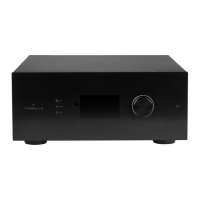22
5. With LFE
When a channel is set to Large, Large and Sub
or Large with Sub, this channel can optionally
reproduce LFE bass which would normally
be the sole responsibility of the subwoofer
channels. When set to None, no LFE will be
mixed into this channel. When set to a figure
between 0dB and -20dB, LFE bass attenuated
by that figure will be mixed into this channel.
This feature is useful when the main channels
have sufficient bandwidth AND dynamic
range to support the subwoofers in creating
an appropriate amount of bass sound
pressure in the room.
6. With SUB
When a channel is set to Large with Sub, this
channel can optionally reproduce the SUB
channel being the internal channel combining
all the extracted bass coming from Small or
Large and Sub speakers. When set to None,
no SUB will be mixed into this channel. When
set to a figure between 0dB and -20dB, the
SUB bass attenuated by that figure will be
mixed into this channel. This feature is useful
when the main channels have sufficient
bandwidth AND dynamic range to support
the subwoofers in creating an appropriate
amount of bass sound pressure in the room.
Although available also for Large and Large
and Sub speakers, it is not recommended to
add SUB bass as the bass of the given channel
would be reproduced twice in that channel.
Note that after making any changes, you must press the
SAVE button near the top right of the screen or you will loose
your changes.
subwoofer channels as well. Set the frequency
below which bass should be sent to the
subwoofer and the slope at which the crossover
occurs.
• Large with Sub: This special case is only available
in the Expert mode. It enables you to effectively
split a full range loudspeaker into a “small speaker”
plus a “virtual subwoofer”. The HPF frequency
and slope define the characteristic of the “small
speaker” portion. LPF frequency and slope define
the virtual subwoofer characteristic. Both are
mixed before being routed to the speakers, thus
making it a Large one from an acoustical stand
point.
Subwoofer channels have specific settings. By
definition, subwoofers have limited bandwidth
and some are more limited than others.
• Low Pass LFE: When this is set to ON, the
subwoofer channel has a low pass filter applied
according to that channel’s Frequency and Slope.
This is designed to limit the channel’s ability to
reproduce the upper portion of the bass spectrum.
This is usually done to prevent the subwoofer
from contributing midrange distortion.
• Subsonic SUB: When this is set to ON, a high pass
filter is applied to the channel which restricts the
subwoofer’s ability to reproduce very deep bass
according to the frequency and slope defined for
that channel. Many subwoofers, especially smaller
models do not have the amplifier power or driver
displacement required to accurately reproduce
very deep bass. By actively filtering very deep
bass away from the subwoofer, it is better able to
reproduce bass within it’s useful bandwidth.
3. Frequency
When the channel is set to Small, Large
and Sub or Large with Sub, the crossover
Frequency defines the point below which
bass in this channel is routed to the
subwoofer(s) in standard mode. In Expert
mode HPF to the speaker and LPF to the
subwoofers can be adjusted individually.
Note that the frequency is the -3dB point
along the slope defined in the next column
and is not an absolute cutoff point.
4. Slope
The rate at which bass is ‘crossed over’ into
the subwoofer when the channel is set to
Small or Large and Sub. Both Linkwitz-Riley
and Butterworth type filters are available
with 12dB to 48dB / octave slope (8
th
order).

